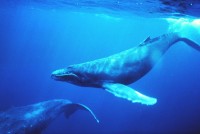Early whaling logs often referred to whales as ‘singers’. All whales use sounds for communication, and most use recognisable patterns, ranging from the haunting tones of bowhead whales to the fast echolocation. Bowheads and bottle nosed dolphins use ‘names’ to identify each other and their clan, have ‘conversations’, and copy each other’s calls.
Bowheads are second only in size to the blue whale, and are very long-lived. Stone harpoon heads, which went out of use at the turn of the 19th century, have been found lodged in the bodies of some individuals of today. Listen to their calls here.
Whales’ land-based ancestors made sounds as we do, using the throat and mouth. But try singing under water! Whales call during dives; whilst holding their breath, and with their mouths closed. Calling is essential for these highly social animals; this is evident because independently both baleen and toothed whales have evolved new ways to produce and transmit sound in the sea.
How are whale sounds made?

A humpback whale (Megaptera novaeangliae) ‘breaching’ off the coast of South Shelter Island, Juneau, Alaska. The flexible throat pleats are visible here as a series of ridges. Since it is unethical to perform invasi... moreve tests on live whales, it has not been proven how these intriguing animals produce sound. Our current understanding is based on studies of the anatomy of already dead whales (Image: Wikimedia Commons). Listen to a selection of humpback calls here:- Call at breeding ground- Call from West Indies- Yups
We produce sound in a tubular organ in our throats; the larynx. This organ is an air valve, closing off the lungs when we swallow, and controlling the outward flow of air. Sound is generated by vibrating paired membranes in the larynx; these ‘chop up’ the airflow into pressure waves. This is then modified by resonating in the chambers of the chest, nose and throat before being released through the mouth.
A humpback’s larynx does not sit across the windpipe. Instead it straddles the opening to an additional air sac located beneath the throat. These whales make sounds by passing air between this sac and the windpipe, vibrating the vocal folds of the larynx. These deep notes are modified and amplified by resonating in the laryngeal sac and nasal cavity, and are thought to be transmitted into the water through the sac, which vibrates the flexible throat pleats somewhat like a hi-fi speaker cone.

Recent work with trained dolphins has solved the mystery of how they generate their echolocation sounds. During a deep dive, a small reservoir of air (around 3% of the original surface volume) remains in the nasal passa... moreges after the lungs have collapsed. Dolphins recycle the air inside this cavity, passing it through the vocal folds of the phonic lips and vibrating them in the same way that we use the larynx. Instead of using internal resonating chambers, muscles controlling the shape of the melon modify the pitch and direction of this sound. This enables dolphins to produce the same pitch and timbre of sounds at any depth of water, regardless of the internal air volume. (Image: Wikimedia Commons)
Dolphins have evolved a secondary set of vocal folds inside their nasal cavities, called ‘phonic lips’. These vibrate like our vocal chords and generating pressure waves.
Because during deep dives the air volume in their nasal cavities becomes very small, their clicks, rasps and whistles do not resonate in inner cavities. Instead, a lens of fatty material on the front of the skull known as the ‘melon’ acts as an underwater ‘speaker cone’, amplifying and transmitting these calls.
Why do whales ‘sing’?
The repetitive, phrased songs of humpback whales are a means of male display. Whilst both genders make sounds, only the males produce song patterns. They copy the signature calls of their clan, serenading unaccompanied females during seasonal migration and at the winter breeding grounds.

A pod of humpback whales (Megaptera novaeangliae) bubble net fishing; Juneau, Alaska. Humpback whales sometimes hunt in groups using a controlled release of air from their blowholes in a decreasing spiral pattern. This ... moreforms a ‘wall’ of bubbles, with which they shoal fish together, ahead of lunge feeding. Watch them bubble net fishing here.
Their behaviour suggests that these breeding areas are a form of ‘floating lek’, where females ‘browse’ amongst available mates. Humpbacks also use other non-singing signals, e.g. when hunting together, females call to communicate with their offspring.
Bottle-nosed dolphins develop their own distinctive signature whistle in the first few months, and exchange these ‘names’ when meeting other dolphins. Females keep their whistle throughout life, whilst males change their signature calls when they move between social groups. Like baleen whales, they also communicate during foraging dives and to maintain social ties.
What can we learn from whale song?

This unusual view of a humpback whale (Megaptera noveangelidae) off the cost of Australia shows the flexible throat pleats in a compressed position.Clans of humpback whales modify the sound pattern of their song through... more each season, and evolve a completely new song form over 15 years. However these animals are able to learn and adapt to change at a much faster rate. A study following the arrival of a handful of male humpback whales from western Australian waters into the eastern Australian humpback population’s breeding grounds, found that the eastern males switched to the western song in only two years. This ‘cultural revolution’ may have been driven by the mating choices of the eastern females; many female mammal species show a preference for novelty in a mate (Image: Wikimedia Commons)
Biologists classify ‘song’ as following ‘a repeating, predictable acoustic pattern’. Most songbirds mimic the calls of their peer group as juveniles. When they mature, this song pattern becomes ‘fixed’. Whales are unusual; they can copy and learn new sounds throughout their lives. Like us, they have a brain structure that continuously learns and can adapt to changes.
The diversity of signature calls and unique song patterns used by clans reveal that whales have a complex and sophisticated system of learnable language. Studying the language and culture of whale populations can thus provide clues about how own language and social complexity may have evolved.
Text copyright © 2015 Mags Leighton. All rights reserved.
References
Adam O et al. (2013) ‘New acoustic model for humpback whale sound production’ Applied Acoustics 74: 1182-1190
Cantor M and Whitehead H (2013) ‘The interplay between social networks and culture; theoretically and among whales and dolphins’ Philosophical Transactions of the Royal Society B 368: 20120340
Cholewiak D M (2013) ‘Humpback whale song hierarchicial structure; historical context and discussion of current classification issues’ Marine Mammal Science 29 3: E312-E332
Cranford, T.W., (2000) "In Search of Impulse Sound Sources in Odontocetes." In Hearing by Whales and Dolphins (Springer Handbook of Auditory Research series), W.W.L. Au, A.N. Popper and R.R. Fay, Eds. Springer-Verlag, New York.
Fitzgerald EMG (2006) ‘A bizarre new toothed mysticete (Cetacea) from Australia and the early evolution of baleen whales’ Philosophical Transactions of the Royal Society B 273:2995-2963
Green SR et al. (2011) ‘Recurring patterns in the songs of humpback whales (Megaptera novaeangeliae)’ Behavioural Processes 86:284-294
Janik VK (2005) ‘Acoustic communication networks in marine mammals’ pp390-415 in Animal Communication Networks McGregor PK (Ed) CUP, Cambridge
Janik VK (2009) ‘Whale song’ Current Biology 19(3)R9-R11
Jensen FH et al. (2011) ‘Calling under pressure; short finned pilot whales make social calls during deep foraging dives’ Philosophical Transactions of the Royal Society B 278:3017-3025
King S L et al. (2013) ‘Vocal copying of individually distinctive signature whilstles in bottlenose dolphins’ Philosophical Transactions of the Royal Society B 280:20130053
Madsen PT et al (2002) ‘Sperm whale sound production studied with ultrasound time/depth-recording tags’ Journal of Experimental Biology 205: 1899-1906
Madsen P T et al. (2002) ‘Male sperm whale (Physeter macrocephalus) acoustics in a high latitude habitat: implications for echolocation and communication’ Behavioural Ecology and Sociobiology 53:31-41
Madsen PT et al (2012) ‘Dolphin whistles; a functional misnomer revealed by heliox breathing’ Biology Letters 8: 211-213
Mercado E and Handel S (2012) ‘Understanding the structure if humpback whale songs’ Journal of the Acoustics Society of America 132(5):2947-2950
Mercado E et al. (2010) ‘Sound production by singing humpback whales’ Journal of the Acoustics Society of America 127(4) 2678-2691 ***NB I am using the broader definition of ‘song’ as applied here by these authors. Janik (2009) suggests that only baleen whales are singers because of their more elaborated song patterns. However toothed whales also use patterns, even though they are clicks and whistles rather than resonating songs.
Møhl B (1999) ‘Dolphin hearing; relative sensitivity as a function point of application of a contact sound source in the jaw and head region’ Journal of the Acoustics Society of America 105(6); 3421-3424
Quick NJ and Janik VM (2012) ‘Bottlenose dolphins exchanges signature whistles when meeting at sea’ Philosophical Transactions of the Royal Society B 279:2539-2545
Reidenberg JS and Laitman JT (2007) ‘Discovery of a low frequency sound source in Musticetae (baleen whales); anatomical establishment of a vocal fold homologue’ Anatomical Record 290: 745-759
Reidenberg JS and Laitman JT (2008) ‘Sisters of the sinuses; cetacean air sacs’ Anatomical Record 291:1389-1396
Smith J N et al (2008) ‘Songs of humpback whales, Megaptera novaengeliae, are involved in intersexual interactions’ Animal Behaviour 76:467-477
Stafford KM (2012) ‘Spitzbergen’s endangered bowhead whales sing through the polar night’ Endangered Species Research 18:95-103








